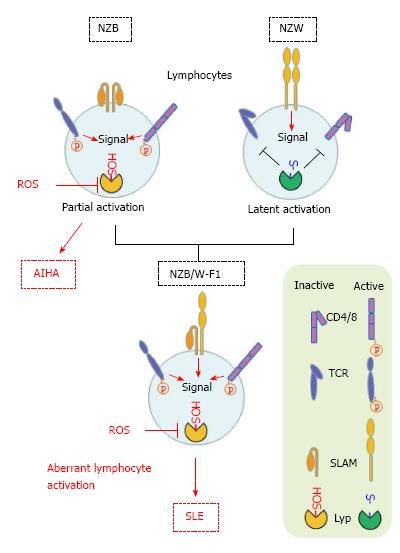Copyright
©The Author(s) 2015.
World J Nephrol. May 6, 2015; 4(2): 213-222
Published online May 6, 2015. doi: 10.5527/wjn.v4.i2.213
Published online May 6, 2015. doi: 10.5527/wjn.v4.i2.213
Figure 3 Hypothetical model for triggering systemic lupus erythematosus in (NZB x NZW) F1 mice.
Lyp/pep suppressively regulates lymphocyte receptors such as CD4/8 and TCR. Production of ROS are originally high in the cells derived from NZB mice and oxidize the sulfhydryl group in the catalytic Cys to sulfenic acid (-SOH). So that Lyp/pep proteins in lymphocytes in the F1 mice are prone to oxidative inactivation. On the other hand, lymphocytes in NZW mice possess the variant form of SLAM that would be responsible for sustained activation of the lymphocytes. (NZB x NZW) F1 mice inherit this potentially pathogenic nature from parental strains. SLE: Systemic lupus erythematosus; ROS: Reactive oxygen species; NZB: New Zealand black; TCR: T-cell receptor; AIHA: Autoimmune hemolytic anemia.
- Citation: Fujii J, Kurahashi T, Konno T, Homma T, Iuchi Y. Oxidative stress as a potential causal factor for autoimmune hemolytic anemia and systemic lupus erythematosus. World J Nephrol 2015; 4(2): 213-222
- URL: https://www.wjgnet.com/2220-6124/full/v4/i2/213.htm
- DOI: https://dx.doi.org/10.5527/wjn.v4.i2.213









